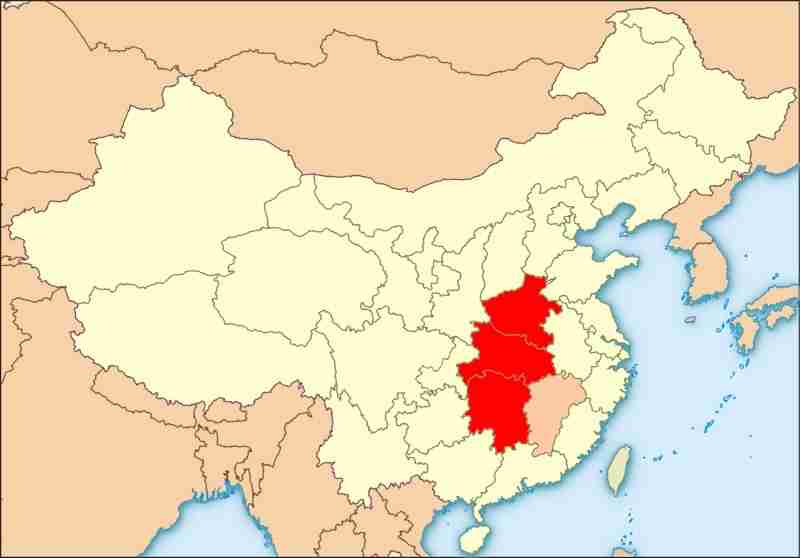China boasts one of the richest cultural setups in the world, and it’s also one of the largest regions of the world geographically. One of the distinct regions of China has got to be Central China, and in this article, we’ll take you through everything you need to know about this region.
So, where exactly is Central China?

Central China is the geographical region that can be loosely described as the cultural region of China that features the provinces of the Hunan, Hubei, and Henan. Jiangxi could also be regarded as one of the parts of the Central China region.
The name notwithstanding, Central China is not actually located in China’s middle region geographically. Instead, it is located much closer to China’s eastern coasts. So, if you took Beijing and Shanghai as the two main points of a triangle, Central China would make the third point.
Central China is located along the banks of the Yangtze River, and as the name suggests, Central China is right at the heart of China, with Hubei as one of its fastest-growing provinces. It also boasts a rather impressive figure in terms of its economic development with a GDP of 7.8% that is always growing – this GDP stands at 1.3% above that of the national average for China.
Currently, Central China is regarded as the official part of China, specifically South Central China that is governed by the People’s Republic of China. And contextually, in the plan dubbed the Rise of Central China Plan that was devised by the State Council of the People’s Republic of China formed in 2004, Central China was also noted to include the surrounding provinces such as Anhui and Shanxi. These provinces are considered part of the development zones for Central China.
At the heart of Central China’s Central Government as per the 2006 strategy is Hubei. Hubei is regarded as Central China’s biggest point of success in the strategic plan that was revisited in 2016 on the 13th review session of Central China’s 5-year plan. This strategy aims to spur consumption in the domestic market while also boosting the overall rate for regional growth and encouraging co-development of entire Central China and its cities, as well as the cities on the coastal areas.
While Hubei is Central China’s Central Government’s location, it’s worth noting that Wuhan is the provincial capital city of Hubei. Wuhan is described as a mega-metropolis. It is a huge part of the cluster of megacities that are based on the Yangtze River’s middle reaches. The development and the location of Wuhan make this city one of China’s First Tier (New) cities which is expected to expand further while spearheading Central China’s development.
Wuhan has a total land area of up to 8,494sq/km, and it features three main townships, namely – Hanyang, Hankou, and Wuchang. Wuhan is, therefore, one of the largest provincial capitals of China.
Note that historically, Wuhan has been regarded as China’s city of immense strategic and economic importance, even in the contemporary Chinese history front. One of the things you may not know about Wuhan is that it is home to China’s very first steel and iron factory that was set up during the reign of the Qing dynasty. And today, the world’s leading steel and iron producer is the Wuhan Iron & Steel Corp or (WISCO)2.
Wuhan is also the city that is widely recognized as the 1911’s Revolution’s birthplace. This revolution is important because it is what transformed China into what modern China is known as today. Note that the city of Wuhan is also China’s key transportation, logistics, and the country’s key railway hub, boasting a large and one of the strongest industrial bases, alongside port facilities that go all the way back to the 1900s. And as one of the key inland transshipment ports thanks to the Yangtze River’s middle stretches, along with the unique positioning of China’s railways, waterways, and highways, it makes sense that Wuhan is Central China’s centerpieces.
And beyond the geographical advantage it enjoys, Wuhan also brims with the best of human capital, as it’s home not just to military tertiary students but also is the resource pool for the city’s main focus areas, including high-precision engineering, optoelectronics, advanced manufacturing, biomedical and green/ new energy solutions.
Central China Provinces
Central China has provinces as the main administrative divisions. These divisions include:
- Henan Province, whose capital is Zhengzhou
- Hubei Province, whose capital is Wuhan
- Hunan Province with Changsha as its capital.
These three provinces are stacked on top of each other, from North to South starting from Henan, then Hubei, and lastly, Hunan. There is also the relatively flat terrain region called the Jianghan Plain, which makes up a large chunk of Hubei, and they’re also the bigger mountain ranges that surround the plains to the south, north, and west.
The other provinces that are in Central China are Shanxi, Anhui,and Jiangxi.
What Cities Are In Central China?

Now that you know the provinces that makeup Central China, let’s take a look at Central China’s biggest and the most important cities.
- Wuhan
- Zhengzhou
- Changsha
- Luoyang (this is Central China’s biggest and most popular tourist attraction in Henan province that is known for the White Horse Temple and the Longmen Caves.
- Xiangfan
- Hengyang
- Yichang
Note that in addition to the big cities, there also are some major rivers that run through the different parts of Central China. These rivers include the Yangtze and Han Rivers located in Hubei, the Yellow and Luo Rivers in Henan, and Hunan’s Yellow River.
The other thing that Central China is known for is its numerous museums. These include:
- The Hubei Provincial Museum
- Temples in Luoyang
- Mulan Prairie, a cultural preserve for the Mongolian customs
- Shaolin Temple
- Zhouzhou’s Train Tracks